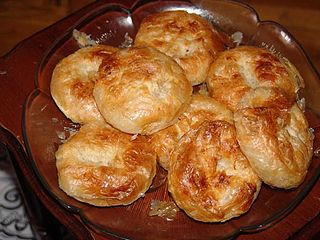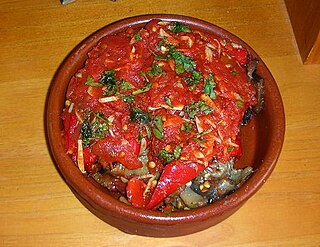
Fried eggplant, or fried aubergine, is featured in dishes of many different cuisines.

Fried eggplant, or fried aubergine, is featured in dishes of many different cuisines.
In Spanish cuisine, this dish takes the form of a tapa . [1] [2] In the province of Córdoba it is usually made with honey. [3]

Fried eggplant (Turkish : Patlıcan kızartma [4] or Patlıcan kızartması [5] [6] ) is found in Turkish cuisine. It is such a common dish during summer months that this season used to be called patlıcan kızartma ayları (fried eggplant months) [7] in Ottoman Istanbul, where this generalized frying caused huge fires and destroyed entire mahalles due to the abundance of old wooden houses. [8] [9] The dish is usually eaten with a garlic yogurt or tomato sauce.

In Southern Italy, especially in Campania region, eggplants are cut into little pieces and therefore fried. Melanzane a funghetto have two variants, the one with tomatoes and the other without. Another recipe which contains fried eggplants is parmigiana di melanzane, famous in all southern regions of the country.
In Arab and Israeli cuisines, fried eggplant is typically served with tahini . In Israel, it is used to make sabich , a popular sandwich of fried eggplant and hard-boiled egg in a pita. [10]

In India, fried eggplant is also known as brinjal phodi or vangyache kaap in the Konkani language. Made with shallow-fried eggplant slices, this recipe is typically a Konkani and Maharashtrian dish, very similar to begun bhaja from Bengali cuisine. [11]

Turkish cuisine is largely the heritage of Ottoman cuisine, Seljuk cuisine and the Turkish diaspora. Turkish cuisine with traditional Turkic elements such as yogurt, ayran, kaymak, exerts and gains influences to and from Mediterranean, Balkan, Middle Eastern, Central Asian and Eastern European cuisines.

Eggplant, aubergine, brinjal, or baigan is a plant species in the nightshade family Solanaceae. Solanum melongena is grown worldwide for its edible fruit.

Meze is a selection of small dishes served as appetizers in eastern Mediterranean cuisines: Syria, Iraq, Cyprus, Greece, Turkey, Lebanon, Jordan, Iran, Armenia. It is similar to Spanish tapas and Italian antipasti. A meze may be served as a part of a multi-course meal or form a meal in itself. Meze are often served with spirits such as arak, rakia, raki, oghi, ouzo, or grappa at meyhane and ouzeri or at regular restaurants.

Dolma is a family of stuffed dishes associated with Ottoman cuisine, typically made with a filling of rice, minced meat, offal, seafood, fruit, or any combination of these inside a vegetable or a leaf wrapping. Wrapped dolma, specifically, are known as sarma, made by rolling grape, cabbage, or other leaves around the filling. Dolma can be served warm or at room temperature and are common in modern cuisines of regions and nations that once were part of the Ottoman Empire.

Parmigiana, also called parmigiana di melanzane, melanzane alla parmigiana or, in the United States, eggplant parmesan, is an Italian dish made with fried, sliced eggplant layered with Parmesan cheese and tomato sauce, then baked. The origin of the dish is claimed by the regions of Campania, Sicily, and Emilia-Romagna.

Levantine cuisine is the traditional cuisine of the Levant, in the sense of the rough area of former Ottoman Syria. The cuisine has similarities with Egyptian cuisine, North African cuisine and Ottoman cuisine. It is particularly known for its meze spreads of hot and cold dishes, most notably among them ful medames, hummus, tabbouleh and baba ghanoush, accompanied by bread.

Maqluba is a traditional Levantine dish, a variety of Pilaf that is popular across Palestine, Jordan, Syria, Lebanon, and Iraq. It consists of meat, rice, and fried vegetables placed in a pot which is flipped upside down when served, hence the name.

Sabich or sabih is a sandwich of pita or laffa bread stuffed with fried eggplants, hard-boiled eggs, chopped salad, parsley, amba and tahini sauce. It is a staple of Israeli cuisine and was created by Iraqi Jews in Israel in the 1960s.

Caponata is a Sicilian dish consisting of chopped fried eggplant/aubergine and other vegetables, seasoned with olive oil, tomato sauce, celery, olives, and capers, in an agrodolce sauce.

Sephardic Jewish cuisine, belonging to the Sephardic Jews—descendants of the Jewish population of the Iberian Peninsula until their expulsion in 1492—encompassing traditional dishes developed as they resettled in the Ottoman Empire, North Africa, and the Mediterranean, including Jewish communities in Turkey, Greece, Bulgaria, North Macedonia, and Syria, as well as the Sephardic community in the Land of Israel. It may also refer to the culinary traditions of the Western Sephardim, who settled in Holland, England, and from these places elsewhere. The cuisine of Jerusalem, in particular, is considered predominantly Sephardic.

Many cuisines feature eggplant salads and appetizers.

Patlıcanlı kebap is a Turkish kebab that may be prepared according to various traditions.

Baigan bharta, also spelled bainganbharta or baigan chokha is an Indian dish prepared by mashing or mincing grilled eggplant (baigan) with tomato, onion, herbs and spices, with variations being common from chef to chef. Traditionally, cooking the eggplants over charcoals, inside of a tandoor, barbecue grill or oven, or even directly applying flame to the outside of the fruit infuses the dish with a smoky flavour; the blackened skin is then easily peeled and the eggplant may be further prepared.

Tombet or tumbet is a traditional vegetable dish from Majorca, consisting of layers of sliced potatoes, aubergines and red bell peppers previously fried in olive oil. It is available at almost every local restaurant on the island.

Mizrahi Jewish cuisine is an assortment of cooking traditions that developed among the Mizrahi Jewish communities of the Middle East, North Africa and Central Asia. Influenced by the diverse local culinary practices of countries such as Morocco, Libya, Egypt, Iraq, Iran, Yemen, and Syria, Mizrahi cuisine prominently features rice, legumes, meats, and an array of spices such as cumin, turmeric, and coriander. Signature dishes include kubbeh (dumplings), pilafs, grilled meats, and stews like hamin.

Malawach or Melawwaḥ, is a Jewish Yemenite flatbread that is traditional in the Yemeni cuisine as well as the Israeli cuisine. The name of the dish comes from the Arabic "ملوح", literally “board-like bread”. It was brought to Israel by Yemenite Jews. Malawach resembles a thick pancake but consists of thin layers of puff pastry brushed with oil or fat and cooked flat in a frying pan. It is traditionally served with hard-boiled eggs, zhug, and a crushed or grated tomato dip. Sometimes it is served with honey.
Eggplants with honey - The recipe we prepare today has become a classic of tapas.
[Found] in a tapas restaurant in Barcelona.[ permanent dead link ]
In Córdoba and Malaga, southern Spain, this is a classic.[ permanent dead link ]